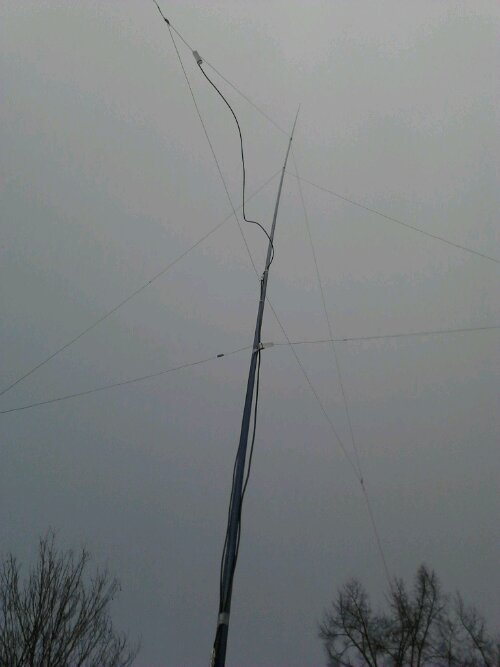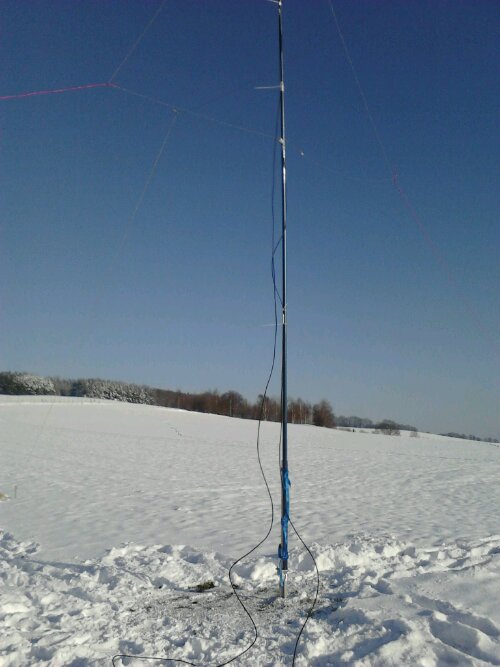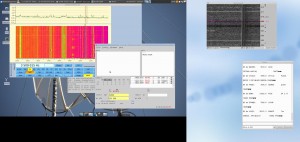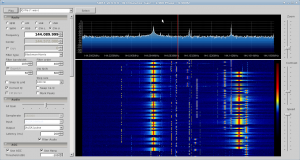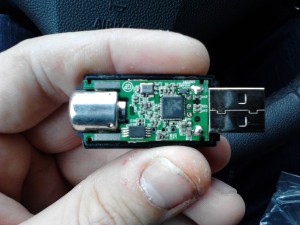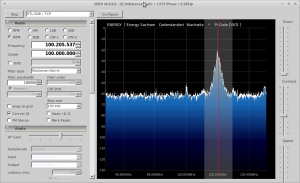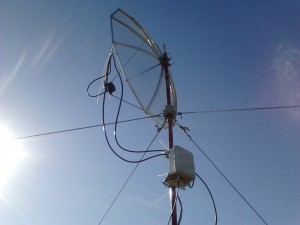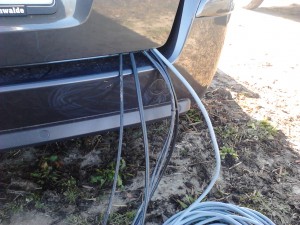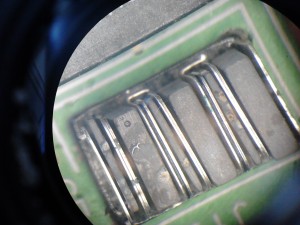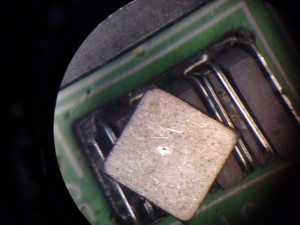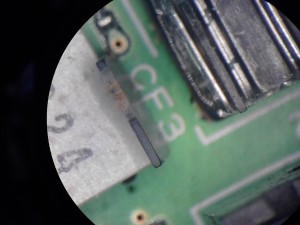For the 10m Contest in January i made 2 Delta Loop antennas.
10 Euro SDR from Hongkong
Recently i purchased a cheap RTL2838+ R820T device from a vendor from Hongkong.
The cost was about 10 Euro including shipping.
The video shows some reception with the SDRSharp software.
Tuning range is from about 24MHz to about 1750MHz. I discovered no gaps so far.
Freedv / FDMDV2 – digital voice shortwave
Since a long time David Rowe VK5DGR works on a open-source low-rate voice codec. This project is called codec2.
Now a variant of this codec is used in a amateur radio digital voice mode that was evolved out of the well known FDMDV software.
The mode uses OFDM with 14 carriers DQPSK and 2 pilot carriers with twice the power modulated in DBPSK.
The bandwith is 1kHz, so 2 of the signals would fit to 1 SSB channel. The datarate of the voice is 1375 Bit/s + some data bits for callsign information etc.
Its intended that in the end this mode can also be used for DX connections. Lets see what live tests will bring. On 20m obviously the frequency 14.236MHz is used as center of gravity.
For using the mode you would need either a two-soundcard PC (one for connecting a headset and one for creating the digital modulation signal) or a SDR setup with virtual soundcards. Currently a windows beta release can be downloaded as binary. For Linux you have to download the source and compile it on your own. David created a nice Makefile that downloads and compiles all dependecies.
You find further information on the project page http://freedv.org/tiki-index.php.
Also some videos are linked that show the operation and the audio quality of this digital mode.
How the digital signal of Freedv/FDMDV2 sounds like:
freedv-test
How the decoded audio sounds like (its only 1375bit/s with 1kHz bandwidth!):
REC-0003
RTLSDR with OpenWRT
Last days i spend some minutes getting the RTL_TCP server running with OpenWRT Backfire on one of my WGT634U routers. These routers have a USB2 port and i can connect my NOXON DAB Stick directly.
I crosscompiled the packages. The sources and a Makefile for the OpenWRT build system you can get from the Osmocom page. You definitively need libusb for getting it running.
For the brcm47xx plattform you can find the both packages here:
librtlsdr_0.1.0-1_brcm47xx.ipk
rtl-sdr_0.1.0-1_brcm47xx.ipk
Attention: The both packages have not been added to my Packages file in the directory. So you have to copy them manually and install them to your OpenWRT. The dependencies are resolved automatically.
After that you probably need to configure the firewall on the router to pass port 1234 to the outside and the RTL_TCP server needs to be started with option -a #lan-interface-ip#, otherise the server will listen to localhost only. With my WGT634U i experienced that i cannot set the samplerate to 2MSpl/s. In this case the router reboots after a few seconds. With 1MSpl/s it worked smooth so far.
With running the server on a embedded system you can install the frontend at a completely different location than the client.
HiQSDR,Quisk,SO2SDR
Just trying a bit with my HiQSDR frontend and Quisk together with SO2SDR.
Jim implemented Rigctrl model 2 to Quisk. This makes it operate with other software like fldigi very well.
SO2SDR is a contest log with SDR bandmap and DXCluster. Worked QSO can be marked in the bandmap as well as stations spotted in the cluster.
Unfortunately I do not get IQ signals from Quisk to SO2SDR yet…
See a screenshot:
Marconi Memorial Contest 2012 – JO60TR
I had the chance to run the MMC 2012 from the QTH of DL4DTU in JO60TR. Special thanks to Norbert !
The antenna was a 8ele and about 400wtts with Norberts TS850 + Transverter.
Since i had no equipment to carry despite a PC for logging and calling i decided to give some monitoring with a SDR solution a try. I used my 20Euro Noxon DAB Stick with SDR# to observe the frequency occupation. Surprisingly this simple device did a fairly good job. Unfortunately i was not able to get my CwSkimmer working again although it worked fine before at home. Because of the high density of stations i faced strong QRM. In the end i had about 230 QSO with about 60k points. Thats a fair result for my first MMC and a single antenna system ;)
The short video shows the PA of Norbert, the USB stick for internet connection, the logging PC, the SDR PC with the Noxon stick and (most important ;) ) the heater.
SDR# and RTL-SDR under Xubuntu 12.10
In the CQDL edition of Nov. 2012 there was an article about a SDR software called SDR# (SDRSharp). This tool can work with the cheap so called RTLSDR sticks (for example Noxon DAB sticks and others) and runs under windows and because its written in C# under linux within the mono framework as well.
Because its not that easy to get the stuff running i try to document it here. Just give me a hint if something is missing or wrong.
Thats the status of today…
The versions:
sdrsharp SVN revision 995
Xubuntu 12.10 64bit
RTLSDR from git repository Nov. 1st, 2012
Noxon DAB stick Rev1
Getting SDR# working:
First you need some required packages:
sudo apt-get install mono-complete
sudo apt-get install libportaudio2
Get sdrsharp sources (and the tool to get it):
sudo apt-get install subversion
svn co https://subversion.assembla.com/svn/sdrsharp/
cd sdrsharp/trunk
Build on command line:
xbuild /t:Rebuild /p:Configuration=Release SDRSharp.sln
You will most probably get a warning but no errors.
Try to run the binary with mono:
cd Release
mono SDRSharp.exe
If you get some errors about Portaudio then try the line:
ln -s /usr/lib/x86_64-linux-gnu/libportaudio.so.2 libportaudio.so
in the directory were your binary of SDRSharp is located. Then try again running the binary.
If the GUI comes up quit it.
Download the release package from the SDRSharp page:
http://sdrsharp.com/index.php/downloads
Unpack into a folder of your choice
Go to the binary Release path were your self-compiled binaries are and overwrite all files from the downloaded package by the self compiled. Also copy the symlink you created eventually.
Try to run SDRSharp from the new directory.
In the left top edge of the window there should be a button named „Play“. Right of this there s a selection list. There should be an entry RTL-SDR/TCP. If not download the RTLSDR files from the SDRSharp page and copy into your SDRSharp folder. After restart of the GUI the entry should be visible.
Connecting the RTLSDR:
I have a Noxon DAB Stick Rev1. This one can be tuned between 22MHz and 1100MHz.
The frequency accuracy is relatively poor. I have -51ppm offset from nominal frequency.
Check how it connects:
Plug the stick to the USB port, wait a few seconds, then type dmesg.
[ 7013.844041] usb 1-1: >new high-speed USB device number 2 using ehci_hcd[ 7013.987872] usb 1-1: >New USB device found, idVendor=0ccd, idProduct=00b3[ 7013.987882] usb 1-1: >New USB device strings: Mfr=1, Product=2, SerialNumber=3[ 7013.987888] usb 1-1: >Product: DAB Stick[ 7013.987892] usb 1-1: >Manufacturer: NOXON[ 7013.987897] usb 1-1: >SerialNumber: 0On my other (Ubuntu based) PC i there get the information that some DVB-T driver get loaded automatically.
dmesg gives then:
[ 7116.475304] usb 2-1.1: Product: DAB Stick
[ 7116.475306] usb 2-1.1: Manufacturer: NOXON
[ 7116.475309] usb 2-1.1: SerialNumber: 0
[ 7116.679026] dvb-usb: found a ‚NOXON DAB/DAB+ USB dongle‘ in warm state.
[ 7116.704932] dvb-usb: will pass the complete MPEG2 transport stream to the software demuxer.
[ 7116.706616] DVB: registering new adapter (NOXON DAB/DAB+ USB dongle)
[ 7116.720596] rtl28xxu: rtl2832u_frontend_attach: FC0013 tuner found
[ 7116.729442] DVB: registering adapter 0 frontend 0 (Realtek RTL2832 (DVB-T))...
[ 7116.759431] fc0013: Fitipower FC0013 successfully attached.
[ 7116.759439] Registered IR keymap rc-empty
[ 7116.759545] input: IR-receiver inside an USB DVB receiver as /devices/pci0000:00/0000:00:1d.0/usb2/2-1/2-1.1/rc/rc0/input14
[ 7116.759946] rc0: IR-receiver inside an USB DVB receiver as /devices/pci0000:00/0000:00:1d.0/usb2/2-1/2-1.1/rc/rc0
[ 7116.759951] dvb-usb: schedule remote query interval to 400 msecs.
[ 7116.769919] dvb-usb: NOXON DAB/DAB+ USB dongle successfully initialized and connected.
[ 7116.776795] usbcore: registered new interface driver dvb_usb_rtl28xxu
lsmod shows:
dvb_usb_rtl28xxu 26619 0
rtl2830 18340 1 dvb_usb_rtl28xxu
dvb_usb 24540 1 dvb_usb_rtl28xxu
dvb_core 111077 2 rtl2830,dvb_usb
If thats the case at yours you need to remove the drivers by typing:
sudo rmmod dvb_usb_rtl28xxu
sudo rmmod rtl2830
This needs to be done everytime you plug the stick to the PC in case the driver is loaded automatically.
Get the binaries for the RTLSDR:
this is the project page: http://sdr.osmocom.org/trac/wiki/rtl-sdr
you need to use git for checkout
sudo apt-get install git
Then get the code:
git clone git://git.osmocom.org/rtl-sdr.git
cd rtl-sdr
sudo apt-get install autoconf2.13
sudo apt-get install libtool
sudo apt-get install libusb-1.0-0-dev
follow the instructions for building with autotools:
autoreconf -i
./configure
make
sudo make install
sudo ldconfig
If you do not want to access the dongle as root user you need to install udev rules:
sudo make install-udev-rules
Run the whole thing:
You need to reconnect the RTLSDR stick to the usb before you are able to run the server application.
You can start it with:
rtl_tcp
If that does not work start it with sudo.
Then you can start SDRSharp again.
In the GUI press configure and type localhost in the field „Hostname“.
Keep the other settings for the moment. Press update and close the configuration window.
Then you can start the reception pressing the „Play“ button.
The waterfall window migh look strange. This seems to be a bug. If you rescale the window it should work (at least for a while) afterwards.
The tune frequency can be entered in the field „Center“. Attention: If you invalid frequencies the stick may hook up and you cannot tune anymore. Then you have to replug the stick and start all applications again.
Unfortunately the processor load is extremely high under linux-mono. I get 100% CPU usage on a 2.4GHz AMD64 CPU. This leads to audio stutters. On my I7-2600 i get around 180% load compared to one of the 3GHz cores when decoding FM-stereo with 2MSpl/s and IQ correction switched on.
You could reduce the datarate by starting the rtl_tcp server with option -s 1024000. 512kSpl/s did not work correctly at my side. You need to set the correct rate also in the sdrsharp configuration. If it still stutters switch IQ correction and FM Stereo off to reduce the CPU load.
This screenshot shows SDRSharp receiving a wideband FM broadcast signal. It also features a RDS decoder.
Thats it. Probably it runs smoother under windows. There the installation should be also a bit easier. Unfortunately i do not have any windows system available.
Oct. 2012 DUR Contest
QRV again after a long time beeing absent.
This was the first time i was QRV on 13cm. Although i had just 1W on this band i made some very nice contacts.
There were still good conditions because of a very nice tropo.
Despite foggy wheather in the morning it turned out to be a very nice DUR test this time.
Unfortunately the activity from Stations from within a 100km radius is getting less and less. Without ON4KST chat its rather difficult.
The picture shows my 1.5m dish with the 13cm box below. Many thanks for all the QSO ! Hear you next time, hopefully !
DUR10_12_DH5YM_129.edi
DUR10_12_DH5YM_232.edi
against PLT / PLC
Currently a new draft european standard prEN 50561-1 is widely discussed. Amongst defined notches for amateur radio bands and dynamic notching for shortwave radio stations it also includes raising the allowed levels of PLT signals on mains lines by about 30dB ! This would mean that any SW radio close to such modems will be impossible.
There is a big discussion in forum.darc.de and in hamradioboard. There is the assumption that raising the levels for PLT will cause other electronic manufacturers to claim for higher interference levels as well. In addition future PLT modems will sure also work up to several hundret MHz to get the high bandwiths required for video streaming. This will affect VHF radios, broadcast radio and even TV broadcasting.
Therefore there is a openpetition which allows you to demonstrate your opinion against PLT devices and against this draft european standard:
https://www.openpetition.de/petition/online/schutz-der-ressource-frequenz-vor-elektromagnetischen-stoerungen-durch-plc
Some very interesting background can be found on the pages of the IRT:
http://www.irt.de/de/publikationen/technische-berichte.html
The german body for elaboration of electronic standards DKE will meet today (Oct. 22th) to decide if they will vote for or against this draft standard on european level. Whatever this decision will be it makes sense to vote against PLT in the petition above…
FT-857D filter plaque
I noticed that my FT-857D suddenly had a lack of sensitivity in FM. Looking a bit closer i experienced that only strong FM signals could be received on all bands. The other modes were ok.
Reading a little bit gives an impression what happens. The most common fault seems to be that one of the Toko ceramic filters (one of 3) fails. Usually this is CF1005 which results in low sensitivity and/or crackling noise in AM and FM. For me it was different. No problems with AM. Therefore i expected CF1003 (narrow band FM filter) failed. There is a very good description of the reasons written down by SV8YM.
external link: http://sv8ym.blogspot.com/2010/07/myster…ng-filters.html
Today i disassembled the transceiver and measured the resistance of the filter ports to ground. CF1005 was around 14kOhms both ports, CF1002 around 55kOhm both ports and CF1003 several tenth of kOhms one port and the other 150Ohms only. This causes the pindiode switch to fail which results in very bad sensitivity.
When i tried to disassemble the filter from the board for accident i removed the cap of the filter. Thus i decided to take a close look without removing the filter from the PCB. Find some photos below.
What is visible are the small pieces of material present on the edges of the ceramic plates. This was descibed by SV8YM. One of the plates showed a very big amount of material that forms the short that was measured before. Therefore i removed one plate after each other, cleaned them with a scalpell knife and placed it back to the filter. Special care needs to be taken on the correct position of the small metal plates that contact the ceramic elements with the filters mechanical structure.
After mounting the filter cap again and measuring the resistance it can be seen that it is in normal range again. After assembling the transceiver FM is ok again.
Overall i assume that this repair will not help for a long time because the filter is already damaged. But at least it helps until i collected all necessary spare parts. The problem in general is that the voltage for switching the pin diodes for the RF paths is not decoupled from the filters. DC voltages destroy ceramic filters. This was not taken into account for all filters by the designers of Yaesu. Most probably because of an missing hint in the datasheet of the filter.
I will change the circuit later when replacing the filters.

